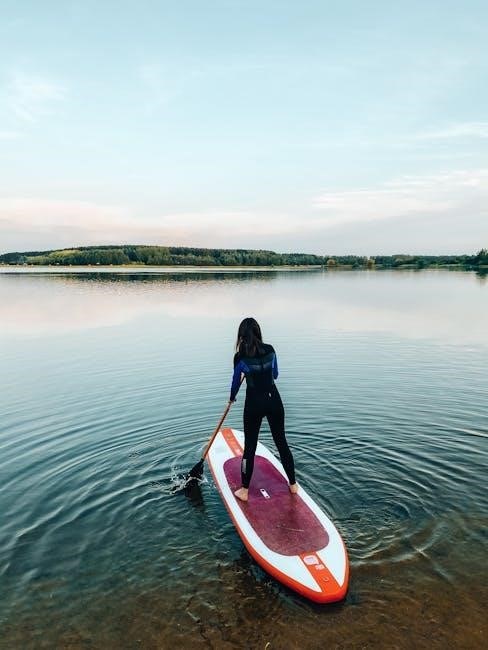Women’s Wetsuit Size Guide: How to Choose the Perfect Fit
Choosing the perfect women’s wetsuit fit is essential for optimal warmth, flexibility, and performance in water sports. Measure height, weight, chest, waist, and hips accurately, and consult a size chart. A snug fit ensures minimal water entry, while thickness varies based on water temperature.
Choosing the right women’s wetsuit size is crucial for optimal performance, comfort, and warmth in water sports. A well-fitting wetsuit acts like a second skin, providing insulation while allowing freedom of movement. Whether you’re surfing, diving, or swimming, the proper fit ensures minimal water entry, reducing heat loss and improving flexibility.
A poor fit can lead to discomfort, restricted movement, or excessive water flushing, which can hinder performance and make your experience less enjoyable. Factors such as height, weight, chest, waist, and hip measurements play a significant role in determining the ideal size. Understanding how these measurements translate to a size chart is key to making the right choice.
Wetsuit thickness also varies based on water temperature, with options ranging from 2mm to 6/5/4mm. This guide will help you navigate the process of selecting the perfect wetsuit, ensuring you stay warm, comfortable, and confident in the water.
Understanding Body Measurements for Wetsuit Sizing
Accurate body measurements are essential for determining the correct wetsuit size. Key measurements include height, weight, chest, waist, hips, neck, and inseam. These measurements help ensure the wetsuit fits snugly, allowing for optimal flexibility and minimal water entry.
Height and weight provide a general size range, while chest and waist measurements are critical for ensuring the wetsuit wraps properly around the torso. Hip measurements are important for women’s wetsuits to ensure a comfortable fit through the hips and thighs. Neck and inseam measurements help with the overall fit, preventing restriction or gapping.
To measure accurately, use a flexible tape measure. For the chest, measure around the fullest part of the bust. The waist is measured at the narrowest point, and hips at the widest part. Neck measurements are taken around the base of the neck, and inseam from the crotch to the ankle bone.

Proper measurements ensure the wetsuit fits like a second skin, providing warmth and flexibility. Always measure over a swimsuit for the most accurate results, and consult a size chart if borderline between sizes.
The Importance of a Proper Fit
A proper fit is crucial for a women’s wetsuit to ensure optimal performance, comfort, and warmth. A wetsuit that fits correctly acts as a second skin, minimizing water entry and maximizing flexibility. If the wetsuit is too tight, it can restrict movement and cause fatigue, while a loose fit allows water flushing, reducing warmth and comfort.

The right fit enhances performance in water sports by providing better mobility and reducing energy expenditure. It also prevents chafing and discomfort, which can distract from the activity. A snug fit around the neck, torso, shoulders, and knees ensures minimal water infiltration, maintaining body heat and reducing the risk of hypothermia.
Proper fit also extends the lifespan of the wetsuit by preventing excessive stretching or tearing. It’s important to consult a size chart and consider thickness based on water temperature. A well-fitting wetsuit boosts confidence and allows for a more enjoyable experience in the water. Always prioritize fit when selecting a wetsuit for the best results.
How to Read a Wetsuit Size Chart
Reading a wetsuit size chart requires careful attention to key measurements, including height, weight, chest, waist, hips, and neck. These measurements help determine the best fit for your body type. Most charts are organized by size, with corresponding ranges for each measurement. For example, a size 4 might correspond to a height of 160-165 cm, a weight of 45-52 kg, and a chest measurement of 77-82 cm.
When interpreting the chart, consider that sizes may vary slightly between brands, so it’s essential to refer to the specific brand’s sizing guide. If you fall between two sizes, opt for the smaller size for a snug, watertight fit. This ensures minimal water entry and maximum warmth. Additionally, some charts include measurements for hips, neck, and inseam, which can further refine the fit.
Thickness, often indicated in millimeters (e.g., 4/3mm), is another factor to consider, as it affects warmth and flexibility based on water temperature. Always measure yourself accurately and consult the chart before making a purchase to ensure the best fit for your needs.
Key Factors Influencing Wetsuit Size

Several factors influence the sizing of women’s wetsuits, ensuring a proper fit for comfort and performance. Height and weight are primary considerations, as they provide a baseline for size selection. Chest, waist, and hip measurements are equally important, as they determine how the wetsuit will fit around the torso and midsection.
Neck and inseam measurements are also crucial, as they affect how the wetsuit sits around the neck and legs, preventing water flushing. Thickness, indicated in millimeters (e.g., 4/3mm), varies based on water temperature and activity level, impacting the fit and flexibility; Body type and personal preference play a role, with some opting for a snug fit for warmth and others preferring a bit more room for ease of movement.

Lastly, brand-specific sizing can vary, so it’s essential to consult each brand’s size chart. Accurate measurements and considering these factors ensure the best fit, maximizing warmth, flexibility, and overall performance in the water.
How to Measure Yourself Accurately
Accurate measurements are essential for selecting the right women’s wetsuit size. Start by using a flexible tape measure and wearing minimal clothing. Measure your height in centimeters or inches while standing straight. Next, measure your weight in kilograms or pounds for a baseline size reference.
For chest measurement, wrap the tape around the fullest part of your bust, keeping it level and parallel to the floor. Your waist measurement should be taken at the narrowest point, usually just above the hipbone. Hips are measured around the widest part of your hips and buttocks, about 7-9 inches (18-23 cm) below the waistline.
Neck measurement is taken around the base of your neck, and inseam is measured from the crotch to the bottom of your ankle. Ensure the tape is snug but not too tight for all measurements. If you’re unsure, consider having someone assist you for accuracy. Proper measurements ensure a wetsuit that fits like a second skin, providing optimal warmth and flexibility in the water.
Choosing the Right Wetsuit Thickness
Wetsuit thickness is crucial for maintaining warmth in cold water while ensuring flexibility. Thickness is measured in millimeters (mm) and varies depending on water temperature. A thicker wetsuit provides more insulation but may reduce flexibility, while a thinner one offers greater mobility but less warmth.
Common wetsuit thicknesses range from 2mm to 6mm, with combinations like 4/3mm or 5/4mm indicating varying thicknesses for different body parts; For cold water (below 12°C), opt for a 5/4mm or 6/5/4mm wetsuit. In temperate waters (12°C-17°C), a 4/3mm wetsuit is ideal. For warmer waters (above 17°C), a 2mm or 3/2mm wetsuit is sufficient;
Consider your activity level and duration in the water, as thicker suits are better for longer sessions. Always balance warmth and mobility to ensure optimal performance. Choose the right thickness based on your needs and the water conditions you’ll be in.
Common Mistakes to Avoid When Selecting a Wetsuit Size
When choosing a wetsuit, several common mistakes can lead to an ill-fitting suit. One of the most frequent errors is sizing up for comfort, resulting in a loose fit that allows water to flush in, reducing warmth and performance. Conversely, sizing down too much can restrict movement and be uncomfortable. Many women overlook the importance of accurate body measurements, relying instead on clothing sizes, which often differ from wetsuit sizing.
Another mistake is not considering the specific size charts of different brands, as sizing can vary significantly. Some individuals also fail to account for their activity level and water temperature, which influence the ideal thickness and fit. Additionally, ignoring the snugness around critical areas like the neck, shoulders, and knees can lead to poor performance and discomfort.

To avoid these pitfalls, always measure yourself carefully, consult the brand’s size chart, and prioritize a fit that feels like a second skin—tight but not restrictive. Avoid guessing your size, as this often leads to dissatisfaction. By being mindful of these common mistakes, you can ensure a wetsuit that performs well and enhances your water experience.
Tips for Maintaining Your Wetsuit
Properly caring for your wetsuit ensures its longevity, flexibility, and performance. After each use, rinse it thoroughly with fresh water to remove salt, sand, and bacteria. Avoid direct sunlight, as UV rays can degrade the neoprene; instead, dry it in the shade or use a wetsuit hanger to prevent stretching.
Store your wetsuit in a cool, dry place, away from sharp objects or heavy items that could cause damage. Never machine wash or dry your wetsuit, as this can damage the neoprene. Instead, hand wash it with a mild, wetsuit-specific cleaner to maintain its integrity.
Avoid using harsh chemicals, oils, or abrasives, as they can break down the material. For minor repairs, use neoprene-specific glue or patches to prevent tears from growing. Regular maintenance not only extends the life of your wetsuit but also ensures it continues to provide optimal warmth and flexibility for your water adventures.
Choosing the right women’s wetsuit size is a crucial step to ensure comfort, warmth, and performance in the water. By accurately measuring your body and consulting a size chart, you can find a wetsuit that fits like a second skin. Proper fit prevents water flushing, reduces restrictions, and enhances flexibility. Remember, a snug fit is essential, but it should never feel restrictive. If you’re between sizes, opting for the smaller one ensures a watertight seal.
Additionally, consider the water temperature and choose the appropriate thickness for your needs. Avoid common mistakes like guessing your size or ignoring key measurements. Taking the time to select the right wetsuit will elevate your water sports experience, providing confidence and comfort. Lastly, maintain your wetsuit with care to extend its lifespan and ensure it continues to perform at its best. With these tips, you’ll be well-equipped to find and preserve the perfect wetsuit for your adventures.